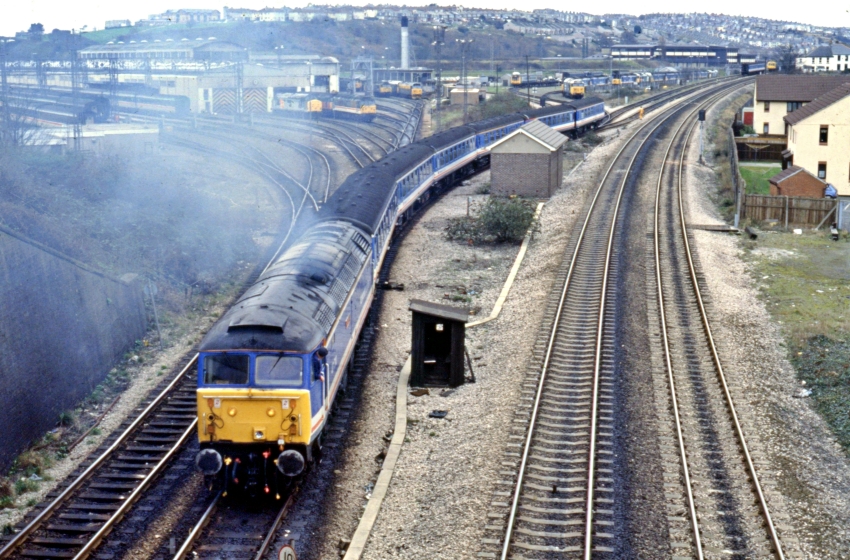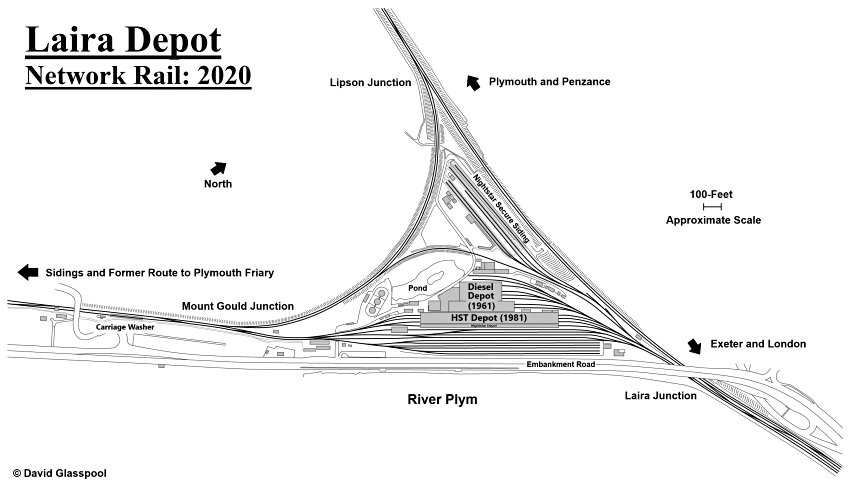Laira Depot
Nightstar
In November 1990 a wholly-owned subsidiary of the British Railways Board, European Passenger Services Ltd (EPS), was established to manage the then proposed daytime and nighttime passenger services through the Channel Tunnel (ref: Reports and Accounts, British Railways Board, 1992). For the latter, by March 1992, a venture by the name of European Night Services Ltd (ENS) had been formed (ref: The Birmingham Post, 27th March 1992). This was jointly owned by EPS (61.5% share), France’s SNCF (11.5% share), Germany’s Deutsche-Bahn (13.5% share), and the Netherlands’ Nederlandse-Spoorwegen (13.5% share); originally, SNCB was to be a shareholder in ENS, but withdrew due to financial reasons (ref: Rails into Europe, A Special Rail Magazine Publication, 1992). The initial routes outlined for the sleeper trains were as follows:
- Scotland (possibly serving both Glasgow and Edinburgh) to Paris and Brussels.
- Swansea to Paris.
- Plymouth to Brussels.
- Waterloo International to Amsterdam.
- Waterloo International to Dortmund and Frankfurt.
(Ref: Rails into Europe, A Special Rail Magazine Publication, 1992)
By January 1995, Nightstar had become the marketing name for the Chunnel sleepers and, as far as the Scottish trains were concerned, only Glasgow was promoted as an origin/destination point.
Maintenance of Nightstar stock was to take place at North Pole International Depot, a facility purpose-built for handling Chunnel passenger vehicles that was located on the opposite side of the Great Western Main Line to Old Oak Common. However, those carriages working to and from Glasgow and Plymouth would also receive overnight servicing at local depots, with an operating diagram that ensured these subsets returned to North Pole every nine days for maintenance (ref: The Railway Magazine, February 1995).
At Plymouth’s Laira Depot, £3.5 million was spent equipping the site for servicing Nightstar stock, which included construction of a single-track shed to accommodate the seven-car subset that would visit on a daily basis (ref: The Railway Magazine, January 1994). The start of building work was formally marked on 10th November 1993 by the Lord Mayor of Plymouth; the selected contractor was Tarmac, and 40% of the money required for the project came from the EC Development Fund (ref: The Railway Magazine, January 1994). The Nightstar shed was built to the same length as the existing triple-track HST 125 maintenance depot, it being physically attached to south eastern side of the latter. In the March 1994 edition of The Railway Magazine, it was noted that an additional set of fuel delivery equipment had been installed at Laira, outside of the main inspection shed; this had been spaced to accommodate a pair of Class 37 diesels with a generator car — a converted BR Mk 3 sleeping carriage — sandwiched in-between the two. Twelve Class 37 diesels were taken from BR’s existing TrainLoad freight sectors and modified to haul Nightstar sleeper services over non-electrified lines, notably those to the South West and Wales. These locomotives became subclass 37/6, and the generator car was required to supply Electric Train Heating (ETH) to the carriages.
The origins of a depot at Laira date back to 1899 when, in that year, the Great Western Railway (GWR) proposed a vote on expenditure for various new works, which included £20,000 on engine sheds in Croes Newydd (Wrexham, Wales) and Plymouth (ref: The Bristol Times and Mirror, 5th August 1899). Laira Shed opened in 1901, from the outset being used mainly for stabling goods locomotives (ref: The Railway Magazine, August 1901). It comprised a roundhouse of 28 tracks feeding off a turntable, positioned in the western corner of a triangle of rails formed by the GWR’s main line from Paddington to Cornwall and the company’s Sutton Harbour branch line. A five-track straight through shed was added to the southern side of the roundhouse in 1931 (ref: An Historical Survey of Great Western Engine Sheds 1947, E. Lyons). In the May 1964 edition of the RCTS’ The Railway Observer, it was reported that the last two steam locomotives allocated to Laira, Nos. 4920 and 4978 ("4900" Hall Class Dumbleton Hall and Westwood Hall respectively), had been transferred to Taunton, leaving withdrawn "1361" Class 0-6-0 No. 1363 as the only engine still there. No. 1363 eventually left under its own steam on 28th August of that year, bound for a temporary home within a contractor’s yard in Totnes, in the care of the Great Western Society (ref: RCTS’ The Railway Observer, October 1964).
The construction of a large depot at Laira for maintaining diesel locomotives and multiple units was reported as being well advanced in July 1960 (ref: The Sphere (London), 30th July 1960). The diesel depot site was situated within the same triangle of lines as the then still extant steam locomotive shed, but on the opposite side of it, having been built upon part of Laira Yard. The latter was a maze of sidings running parallel with the eastern side of the triangle, which even predated the engine shed. Opened in 1961, Laira was one of two depots built by British Railways’ Western Region for the heavy maintenance of diesels, the other being Cardiff Canton (ref: The Railway Magazine, March 1964).
In October 1979 it was announced that E. Thomas Construction of Ponsanooth, Truro — then part of the Mowlem Group — had been awarded a £3.5 million contract by British Rail (BR) for the building of a new depot at Laira (ref: The West Briton and Royal Cornwall Gazette, 18th October 1979). This was in connection with the introduction of the InterCity 125 High Speed Train (HST) fleet on BR’s Western Region. The works involved partially demolishing the existing diesel servicing depot and building a triple-track shed of dimensions 786-feet in length by 72-feet in width, comprising a steel frame clad with sandwiched insulation panels. Additionally, ten stabling sidings were provided, an outside fuelling track, and new washing apparatus (ref: The Railway Magazine, January 1980). The then new depot was formally opened by the Lord Mayor of Plymouth on 30th September 1981, the facility having a staff of over 230 that repaired and maintained 18 HST sets, 68 main line diesel locomotives, 8 diesel shunters, and 16 DMUs (ref: The Railway Magazine, December 1981). Maintenance equipment and servicing capabilities at Laira Depot — which covered an area of 1.5 square miles — included:
- A lathe for re-profiling wheel tyres.
- A 15-ton overhead crane across two tracks.
- Eight lifting jacks to facilitate the removal of bogies from locomotives (including HST power cars) and coaches.
- Ultrasonic axle testing.
- Underframe cleaning.
- Capacity to service fifty carriages daily.
(ref: The Railway Magazine, December 1981)
When Laira’s then new extension opened, locomotive servicing and carriage cleaning was transferred to there from a still extant depot at Newton Abbot (ref: Herald Express (Torquay, Devon), 1st October 1981).
So, what of the Nightstar project? The Nightstar depot building at Laira was reported as being almost complete by September 1994 and, in that month, a new boundary fence was erected at the site; additionally, one of the sidings was securely fenced off, this of which would be used to stable stock overnight that had been customs-cleared (ref: The Railway Magazine, December 1994). Nearly three years after the completion of these facilities at Laira, it was all over for sleeper trains through the Channel Tunnel: on 9th July 1997, London & Continental Railways — the company by then responsible for Chunnel passenger services — officially announced the cancellation of Nightstar, stating that the project was simply not economically viable (ref: Evening Herald (Plymouth), 9th July 1997). By that time, Laira Depot belonged to the Railtrack Property Board (ref: The Railway Magazine, May 1996) and, as far as your author can tell, the Nightstar shed became a normal part of the domestic maintenance operation.
23rd February 1992

Network SouthEast-liveried Class 47 No. 47710 is seen departing Laira hauling the 14:45 empty carriage stock from Lipson Sidings to Exeter St Davids. Lipson Sidings occupied the former site of the engine shed, upon the northern side of the area within the triangle of lines. One of Lipson Sidings was encircled with fencing in 1994 to form a secure area to stable customs-cleared "Nightstar" stock, and the track retains this barricade today. The main depot building seen in the left background is that of the 1981-completed HST depot; the "Nightstar" shed was built over the track to the immediate left and is marked on the diagram on this page. The double-track on the right of this westward view is that from Exeter to Plymouth; Laira Junction is behind the camera. © David Glasspool Collection
Return to the Kent Rail Homepage or alternatively, check for Updates.
Website & Copyright information - Links - Contact the Webmaster

